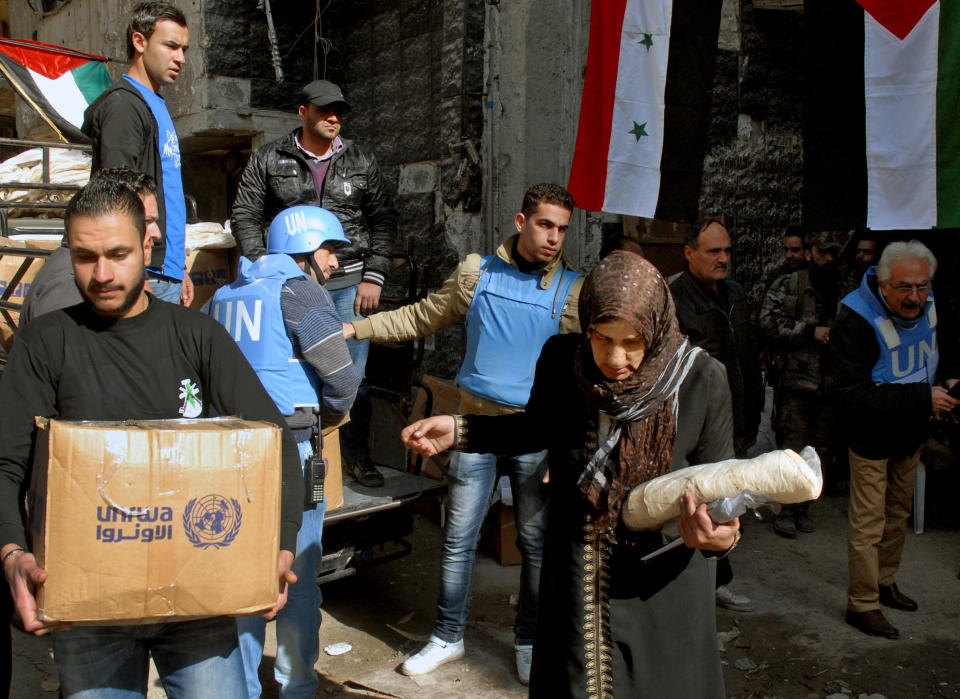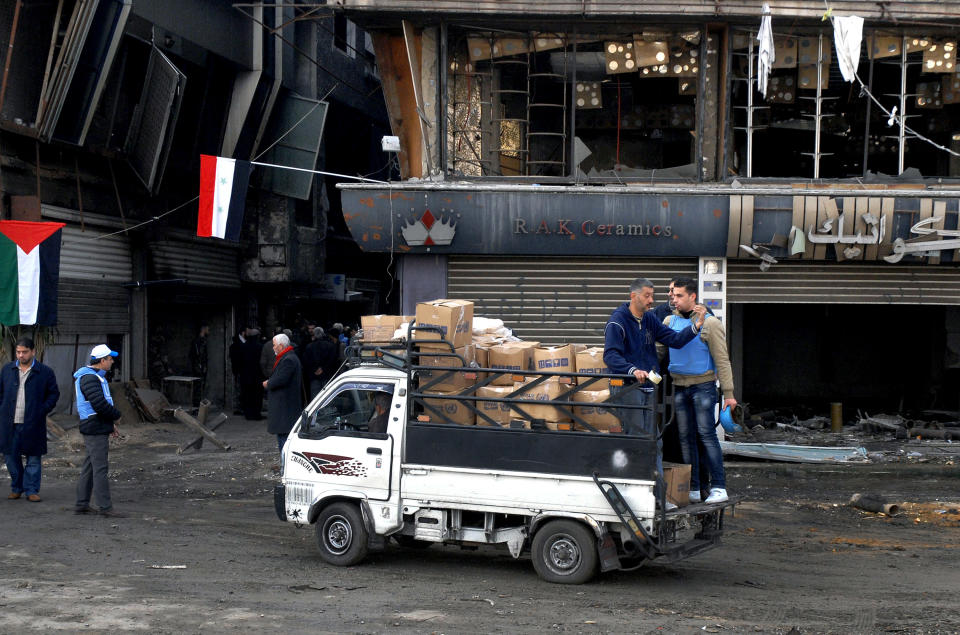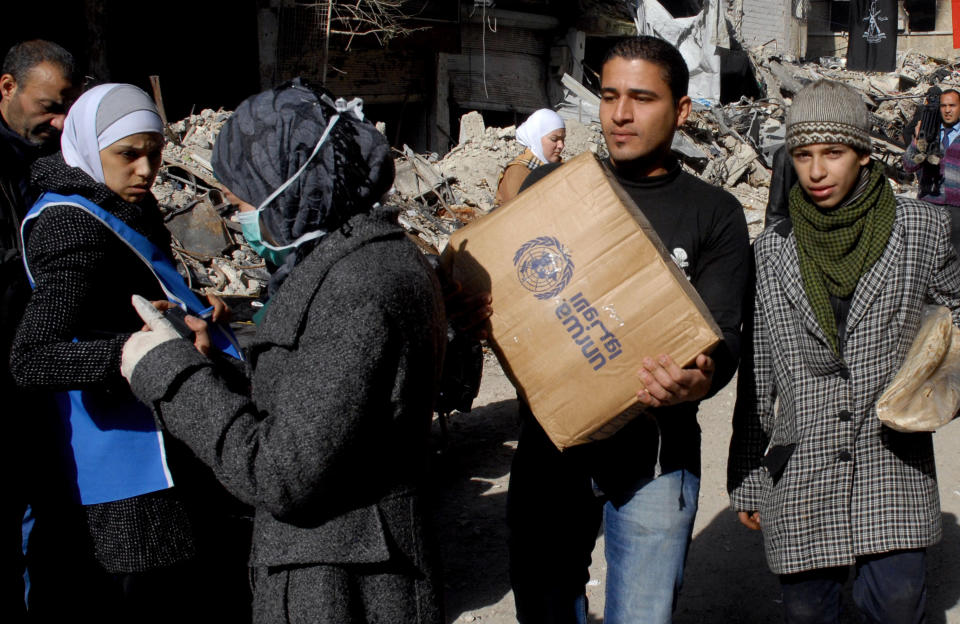Food supplies enter Palestinian camp in Syria
DAMASCUS, Syria (AP) — The United Nations delivered hundreds of relief parcels Thursday to a besieged rebel-held Palestinian neighborhood in the Syrian capital that has suffered from crippling shortages of food and medicine for months, U.N. and Palestinian officials said.
The Yarmouk camp, located on the southern edge of Damascus, is one of the hardest-hit of a number of opposition enclaves under tight blockades imposed by pro-government forces. Activists said Wednesday that at least 85 people had died in Yarmouk since mid-2013 as a result of starvation and illnesses exacerbated by hunger or lack of medical aid.
Activists and aid groups have accused forces loyal to President Bashar Assad of using starvation as a weapon of war, and called for immediate humanitarian access to the stricken areas. The need to open humanitarian corridors to relieve civilian suffering in blockaded areas has been one of the topics discussed at ongoing peace talks in Switzerland between the Syrian government and the opposition.
Despite encouraging signs early in the Geneva discussions, no concrete progress has been made on that front.
Chris Gunness, a spokesman for the U.N.'s UNRWA agency that supports Palestinian refugees, said a convoy carrying 900 food parcels entered Yarmouk on Thursday morning. He added that despite "chaotic scenes," by noon 720 parcels had been distributed.
"We are encouraged by the delivery of this aid and the cooperation of the parties on the ground," Gunness said. "We hope to continue and increase substantially the amount of aid being delivered because the numbers of those needing assistance is in the tens of thousands, including 18,000 Palestinians, among them women and children."
"With each passing hours their need increases," he said.
Anwar Raja, a Palestinian official in Syria, said a number of elderly people will be evacuated from Yarmouk later in the day. Raja said the parcels were transported by pick-up trucks that were inspected by members of Palestinian factions holding Yarmouk, and that deeper inside the camp the parcels will be carried on foot.
Authorities recently allowed a few hundred food parcels into Yarmouk in what appeared to be a goodwill gesture ahead of the peace talks, but residents said only a tiny amount entered because government officials ordered aid workers to distribute the parcels in an area under sniper fire.
In the nearby suburb of Daraya, meanwhile, Syrian army helicopters dropped barrels packed with explosives and fuel, killing at least 11 people including three children, the Britain-based Syrian Observatory for Human Rights said. The crude barrel bombs cause extensive damage, and have been used extensively by the military over the past two months to pound opposition areas, particularly in the northern city of Aleppo.
An amateur video posted online showed a massive explosion kicking huge clouds of dust and smoke over Daraya's concrete-block rooftops. The video appeared genuine and corresponded to other AP reporting of the events depicted.
Activists also reported that airstrikes killed at least eight people in the Qadi Askar neighborhood of Aleppo.
Syria's conflict, which began as largely peaceful protests before shifting into an armed insurgency, has exacted a devastating toll on the country, killing more than 130,000 people and forcing 2.3 million to seek refuge abroad. The economy lies in ruins, as do the nation's cities, towns and villages.
In a new report released Thursday, Human Rights Watch accused the government of using controlled explosions and bulldozers to raze thousands of residential buildings, in some cases entire neighborhoods, in a campaign that appeared designed to punish civilians sympathetic to the opposition or to cause disproportionate harm to them.
The demolitions took place between July 2012 and July 2013 in seven pro-opposition districts in and around the capital, Damascus, and the central city of Hama, according to a 38-page report by Human Rights Watch. The New York-based group said the deliberate destruction violated international law, and called for an immediate end to the practice.
The report includes satellite images of the neighborhoods before and after the demolitions, providing a window on the scale of the destruction.
Buildings in the Hama neighborhood of Masha al-Arbaeen, a wedge-shaped district bordered by highways on three sides, are clearly visible in a photo dated Sept. 28, 2012. In a second photo from Oct. 13, the buildings have been pulverized into a white smudge, while the adjacent neighborhoods remain untouched.
In the Netherlands, the international chemical weapons watchdog was meeting Thursday to discuss slow progress in its mission to destroy Syria's chemical weapons stockpile by the end of June. Syria agreed to relinquish its arsenal after a deadly chemical attack in August on a rebel-held suburb of Damascus raised the possibility of punitive U.S. missile strikes.
In a note prepared last week for the meeting of the executive council of the Organization for the Prohibition of Chemical Weapons, Director-General Ahmet Uzumcu said he spoke to U.N. Secretary-General Ban Ki-moon "and they both agreed that it was necessary for the removal process to pick up pace."
Under a timeline drawn up last year, the most toxic chemicals in Syria's 1,300-metric-ton stockpile were to have been removed from the country by Dec. 31, but that deadline was missed due to poor security in Syria as well as other factors.
So far, just two small consignments of chemicals have been shipped out. One of the shipments came after Uzumcu's note was written.
Uzumcu said in the note that Syria had informed him of "certain security threats," but insists it is committed to removing the chemicals "as soon as possible." He did not elaborate on the nature of the threats.
___
Mroue reported from Beirut. Associated Press writer Mike Corder in The Hague, Netherlands, and Ryan Lucas and Yasmine Saker in Beirut contributed to this report.




